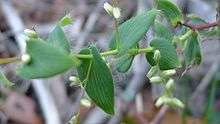Leucopogon amplexicaulis
| Beard-heath | |
|---|---|
 | |
| Scientific classification | |
| Kingdom: | Plantae |
| (unranked): | Angiosperms |
| (unranked): | Eudicots |
| (unranked): | Asterids |
| Order: | Ericales |
| Family: | Ericaceae |
| Genus: | Leucopogon |
| Species: | L. amplexicaulis |
| Binomial name | |
| Leucopogon amplexicaulis (Rudge) R.Br. | |
Leucopogon amplexicaulis, commonly known as the beard-heath, is a shrub found in southeastern Australia.[1]
English botanist Edward Rudge was the first to describe this species as Styphelia amplexicaulis in 1807.[2] It was later renamed by the prolific Scottish botanist, Robert Brown in his 1810 work Prodromus Florae Novae Hollandiae.[3] The species name is Latin for "stem-clasping" and refers to the leaves.[4]
It grows as a slender plant up to 0.9 m (3 ft) high, sometimes with a scrambling habit. The small branches have fine hairs. The leaves measure 9.5 to 34 mm in length by 4.5 to 20 mm across,[1] and are distinctively heart-shaped and surround the stem at their base.[5] The white flowers appear from July to November, peaking over August and September.[6] Three to twelve small tubelike flowers arise along stalks up to 3.7 cm long.[1] These are followed by the development of fleshy fruit known as drupes which are ripe from September to December.[6]
Leucopogon amplexicaulis ranges from the Sydney Basin south to Shoalhaven on the New South Wales South Coast. It is found on sandstone soils in sclerophyll forest, where it grows in sheltered locations on sandstone outcrops and platforms, often near natural seepage.[1] In the Sydney region it is associated with trees such as Sydney peppermint (Eucalyptus piperita), red bloodwood (Corymbia gummifera) and smooth-barked apple (Angophora costata), and shrubs such as heath banksia (Banksia ericifolia), coral fern (Gleichenia dicarpa) and dog rose (Bauera rubioides).[6]
Plants live between twenty and thirty years, and become more common in areas long unburnt by bushfire. Leucopogon amplexicaulis is killed by fire and regenerates by seed. The seeds are thought to possibly be dispersed by ants.[6]
Members of the genus Leucopogon are seldom cultivated, as their propagation by seed or cutting can be difficult. L. amplexicaulis requires a well drained site with ample moisture and dappled shade in a garden situation.[4]
References
- 1 2 3 4 J. M. Powell. "New South Wales Flora Online: Leucopogon amplexicaulis". Royal Botanic Gardens & Domain Trust, Sydney, Australia.
- ↑ "Styphelia amplexicaulis Rudge". Australian Plant Name Index (APNI), IBIS database. Centre for Plant Biodiversity Research, Australian Government.
- ↑ "Leucopogon amplexicaulis (Rudge) R.Br.". Australian Plant Name Index (APNI), IBIS database. Centre for Plant Biodiversity Research, Australian Government.
- 1 2 Elliot, Rodger W.; Jones, David L.; Blake, Trevor (1993). Encyclopaedia of Australian Plants Suitable for Cultivation: Volume 6 (K-M). Port Melbourne: Lothian Press. pp. 147–150. ISBN 0-85091-589-9.
- ↑ Fairley, Alan; Moore, Philip (2000). Native Plants of the Sydney District:An Identification Guide (2nd ed.). Kenthurst, NSW: Kangaroo Press. p. 88. ISBN 0-7318-1031-7.
- 1 2 3 4 Benson, Doug; McDougall, Lyn (1995). "Ecology of Sydney Plants 3: families Cabombaceae to Eupomatiaceae" (PDF). Cunninghamia. 4 (2): 217–429.